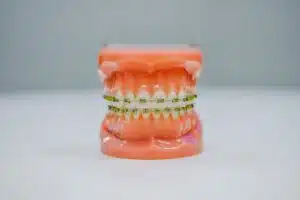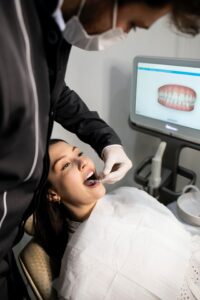Exploring Your Options: Braces and Invisalign in Shoreline
Key Takeaways
- Braces and Invisalign are both effective orthodontic treatments for correcting dental misalignment.
- Braces use metal or ceramic brackets and wires, while Invisalign employs a series of clear aligners.
- Factors such as treatment duration, visibility, and lifestyle preferences play a role in choosing between braces and Invisalign.
Choosing between braces and Invisalign can be a significant decision when it comes to correcting dental misalignment and getting the benefits of orthodontic treatments. This comprehensive guide aims to explore the key features, pros and cons, and factors to consider when making your decision. By the end, you’ll be equipped with the knowledge to choose the right orthodontic treatments for your needs in Shoreline, whether it’s braces or Invisalign in Shoreline, WA.
Understanding Braces
Braces have stood the test of time and remained one of the most popular orthodontic treatments for several reasons. Firstly, braces are highly effective in correcting a wide range of dental misalignments. Whether it’s overcrowded teeth, gaps, overbites, underbites, or crossbites, braces provide the necessary control and force to move teeth into their proper positions. Their versatility allows orthodontists to address complex cases and achieve optimal orthodontic results.
The key to braces’ effectiveness lies in their design. The metal or ceramic brackets are strategically bonded to the teeth, providing a stable anchor for the treatment. The wires, often made of high-quality materials like stainless steel or nickel-titanium, exert controlled pressure on the teeth, guiding them into alignment over time. Orthodontists carefully adjust the wires during regular appointments, gradually shifting the teeth and ensuring progress is made according to the treatment plan.
Moreover, braces offer precise control over tooth movement. Orthodontists can make targeted adjustments to address specific dental issues, such as rotating teeth or correcting bite problems. This level of customization allows for comprehensive treatment and helps achieve not only a straighter smile but also an improved bite function.
Introducing Invisalign
Invisalign has gained significant popularity as a modern alternative to traditional braces. One of its key advantages is its virtually invisible appearance. Instead of metal brackets and wires, Invisalign utilizes a series of clear, custom-made aligners that fit snugly over your teeth. These aligners are made from a smooth, transparent plastic material, making them difficult to detect when worn.
The discreet nature of Invisalign aligners addresses the aesthetic concerns that some individuals may have with other orthodontic treatments. People who are self-conscious about the appearance of metal braces can opt for Invisalign and enjoy a more subtle orthodontic treatment experience. This feature is particularly appealing to teenagers and adults who may feel hesitant about wearing visible braces in social or professional settings.
In addition to its aesthetic advantages, Invisalign aligners offer a high level of comfort. The aligners are custom-designed using advanced 3D imaging technology, ensuring a precise fit for your teeth. The smooth plastic material eliminates the discomfort and potential irritation often associated with metal brackets and wires. Furthermore, the aligners are removable, allowing you to enjoy your favorite foods without restrictions and facilitating easy oral hygiene practices.
Advantages and Challenges: Braces
Possible Advantages
- Braces are effective for correcting a wide range of dental misalignments, including severe cases.
- They are recommended for complex orthodontic issues that may require targeted adjustments.
- They provide precise control over tooth movement for optimal results.
- Braces are permanently fixed to the teeth, eliminating the risk of losing or misplacing them.
- They can address not only teeth alignment but also bite issues and jaw discrepancies.
- Modern braces offer a variety of options, such as ceramic brackets that are less noticeable than traditional metal brackets.
- Braces have a long-standing track record of success, with extensive research and proven results.
- Regular orthodontic visits during the treatment allow for close monitoring of progress and adjustments as needed.
- Braces are a non-removable orthodontic treatment option, which ensures consistent treatment and reduces the temptation to skip wearing them.
- Advances in orthodontic technology have led to more comfortable braces, with mechanisms like self-ligating brackets and 3D-printed brackets that require fewer adjustments and result in reduced discomfort.
Possible Challenges
- Braces are visibly noticeable on the teeth.
- Braces can cause initial discomfort or soreness.
- Cleaning around brackets and wires can be challenging.
- Certain foods must be avoided to prevent damage to the braces.
- Loose or broken brackets/wires may require emergency visits.
- Periodic adjustments of braces can cause temporary discomfort.
- Treatment with braces may take longer, especially for complex cases.
- Speech may be temporarily affected by the presence of braces.
- Brackets or wires can occasionally irritate the inner cheeks or lips.
- Participation in contact sports or playing specific instruments may require additional precautions.
Advantages and Possible Challenges: Invisalign
Possible Advantages
- The clear aligners offer a virtually invisible orthodontic treatment option.
- They provide a more discreet alternative to traditional braces, particularly for those concerned about appearance.
- Aligners are removable, allowing for easier cleaning and maintenance of oral hygiene.
- The ability to remove them allows for more freedom in eating and drinking without dietary restrictions.
- Aligners are generally more comfortable than traditional braces, as they do not have brackets or wires that can cause irritation.
- Custom-made aligners provide a precise and personalized treatment plan for each individual.
- They can effectively treat mild to moderate dental misalignments and address orthodontic concerns.
- The treatment process is often less time-consuming compared to traditional braces.
- Aligners can be a good option for individuals involved in contact sports or playing specific musical instruments.
- Treatment involves fewer visits to the orthodontist compared to traditional braces.
Possible Challenges
- Consistency in wearing the aligners for the recommended hours each day is crucial for effective results.
- Failure to comply with wearing the aligners as instructed can prolong the treatment duration.
- Invisalign may not be suitable for complex orthodontic cases or severe dental misalignments.
- Temporary speech changes or a slight lisp may occur during the adjustment period.
- Invisalign treatment may be more expensive than traditional braces, depending on the individual case.
- Certain lifestyle factors, such as smoking or frequent consumption of colored beverages, can stain the aligners.
- Attachments or buttons may be necessary to achieve specific tooth movements, which can be visible.
- Aligners may not provide the same level of control as braces for certain bite or jaw-related issues.
- Additional refinement or adjustment may be needed after the initial treatment with aligners.
- Occasional appointments for progress checks and to receive new sets of aligners may be required.
Choosing the Right Treatment for You
When it comes to choosing between braces and Invisalign, there are several important factors to consider. These considerations will help you make an informed decision about the most suitable orthodontic treatment for your specific needs. Consulting with a reliable orthodontist in Shoreline will provide valuable insights and guidance throughout the evaluation process. Here are some key factors to consider:
The Complexity of Your Case
The complexity of your dental misalignment plays a significant role in determining the most appropriate treatment option. Braces are highly effective in addressing a wide range of cases, including severe misalignments and complex orthodontic issues. On the other hand, Invisalign may be more suitable for mild to moderate misalignments.
Treatment Duration
The length of treatment is an important consideration for many individuals when it comes to orthodontic treatments. While the duration varies depending on the case, braces are generally known to have a longer treatment time compared to Invisalign.
Visibility Concerns
The visibility of the orthodontic treatment is often a significant consideration, particularly for individuals who are conscious of their appearance during the treatment period. Traditional braces are more noticeable due to their metal brackets and wires, while Invisalign aligners are virtually invisible. If having a discreet treatment option is important to you, Invisalign may be the preferred choice.
Lifestyle Preferences
Your lifestyle and daily routines are important factors to consider. Invisalign aligners are removable, allowing you to eat, drink, and maintain oral hygiene without significant restrictions. However, this also requires discipline and commitment to wearing the aligners for the recommended hours each day. If you prefer the convenience of removing the orthodontic appliance for specific activities, such as eating or playing sports, Invisalign may be a better fit for your lifestyle.
Budget Considerations
Cost is another significant factor to take into account. The cost of orthodontic treatments can vary based on the complexity of your case, the treatment duration, and the specific orthodontic care provider. In some cases, Invisalign may be more expensive than traditional braces.
Orthodontist Expertise and Recommendations
Finding a reliable and experienced orthodontist in Shoreline is crucial in determining the best treatment option for you. Seek recommendations from trusted sources, such as friends, family, or your dentist. Schedule consultations with different orthodontists to discuss your case, ask questions, and evaluate their expertise, qualifications, and treatment approach. Their professional guidance and recommendations will provide valuable insights to help you make an informed choice.
Finding a Reliable Orthodontist in Shoreline, WA
To ensure the best possible outcome, it’s crucial to choose an experienced and reputable orthodontist in Shoreline. Seek recommendations from friends, family, or your dentist, and schedule consultations with different orthodontists to discuss your treatment options. Consider their expertise, qualifications, treatment approach, and patient care reviews before making your decision.
At Spain Orthodontics in Shoreline, we understand that you deserve treatment that is not only effective but also comfortable, fast, and affordable. We prioritize your comfort throughout your orthodontic journey. Our experienced orthodontist and team utilize advanced techniques and technology to ensure that your treatment is as comfortable as possible. Whether you choose braces or Invisalign, we will customize your treatment to maximize comfort and minimize any potential discomfort.
We believe that quality orthodontic treatments should be accessible to everyone. That’s why we offer flexible payment plan options, and special financing, and work with insurance carriers to make your treatment as affordable as possible. Contact us today to schedule a consultation and take the first step toward your dream smile!
Similar Posts
(ADD HERE)
The cost of Invisalign treatment can vary, but it may be slightly more expensive than traditional braces in some cases.
Both braces and Invisalign can cause temporary discomfort or soreness during the adjustment period, which typically subsides over time.
Switching from braces to Invisalign or vice versa depends on various factors and should be discussed with your orthodontist to assess the feasibility based on your specific case.
There are potential complications and risks of orthodontic treatments, such as tooth sensitivity, gum irritation, or temporary changes in speech, but these are usually minimized with proper care and regular monitoring by your orthodontist.
Both braces and Invisalign require proper oral hygiene practices, with braces requiring extra attention to clean around the brackets and wires, while Invisalign aligners can be removed for easier brushing and flossing.
In many cases, orthodontic treatment can still be provided with existing dental restorations, but your orthodontist will assess the condition and recommend any necessary adjustments or replacements to ensure treatment success.
It is generally not recommended to undergo teeth whitening treatments while wearing braces or Invisalign aligners due to potential uneven whitening, but it is advisable to discuss options with your orthodontist after treatment completion.
To minimize discomfort, you can take over-the-counter pain relievers as recommended, use orthodontic wax for irritation, rinse with warm saltwater, choose softer foods initially, and follow proper oral hygiene practices.





